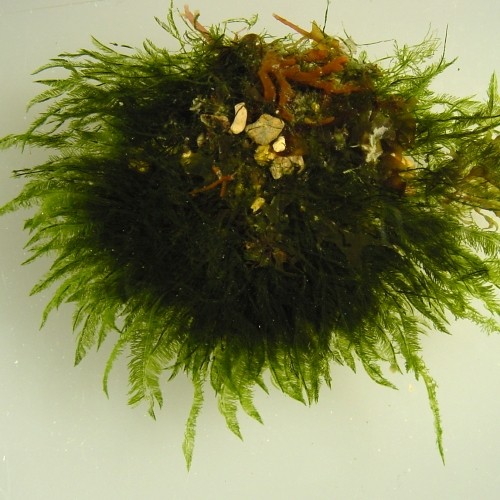
Main Page | References
Bryopsis pennata J.V.Lamour.

Bryopsis pennata J.V.Lamour.
Description: Plants erect but soft, in tufts or wide patches, with one to many erect axes, 1-12 cm tall, rarely to 20 cm. Light to dark green in color, sometimes with a brilliant bluish iridescence. Attached by basal rhizoids which can produce additional erect axes. Branching appearing opposite or relatively unilateral or a varying mixture of both, not becoming radial lower down on larger axes. Branchlets formed at the tips of main axes rarely branching themselves. Main axes rarely with secondary or higher order branching except in very large, damaged or drift plants. Branches noticeably constricted at their bases, even shortly after their formation, rarely not constricted. Main branches 100-200 (-500) mm diam., ultimate branchlets 50-150 mm diam.,occasionally larger. Plastids discoid to fusiform. Gametes formed in lateral branchlets, released through small pores at the tip and the base of the branchlet.Introduction and Origin: Native to Hawaii.
Hawaiian Distribution: Northwest Hawaiian Islands and all main islands.
Habitat: Common. Found in a wide variety of habitats, from mid intertidal to at least 20 m deep. Often found in calm, sediment-rich, estuarine waters, or areas or low salinity. Can be found in tidepools, harbors, reef flats, channels in reef crests and in deeper w
Environmental Effects: Not studied. May affect recruitment of other species by successfully competing for substrate.
World Distribution: Worldwide in warm waters
Commercial Interests: Plants of the genus Bryopsis are considered pests in aquariums, and are reportedly difficult to erradicate. This genus is known to produce several secondary compounds. One of the best studied is the toxin bryostatin, a macrocyclic lactone which is toxic for fish and many invertebrates, and is being used in oncological research (Grant, 1997).
Rate of Spread / Method: Growth rate unknown. Propagates through spores, gametes, and possibly by fragmentation.
Factors likely to influence Spread and Distribution: Relatively calm waters, low salinity, high nutrients availability.
Reasons for Success: Anthropogenic sources of nutrients (fertilizers runoff, sewage), lack of, or no significant grazers pressure.
Control Methods: None used.
References: http://www.globaldialog.com/~jrice/algae_page/bryopsis.htm Grant, S. (1997) Modulation of ara-c induced apoptosis in leukemaia by the PCK activator Bryostatin 1. Frontiers in Bioscience 2, d232-241.